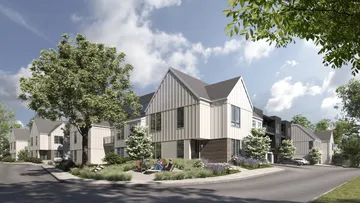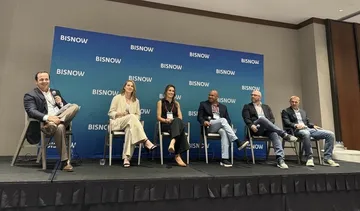
Master Planning Strategies for Build-to-Rent Communities Maximizing ROI Through Design and Location
Renters increasingly lease with an aspirational vision of their best selves.
Chris Yuko, Managing Director of Development, Marquette Companies
Since 2019, build-to-rent (BTR) communities have surged by over 300% (Fast Company) in the multifamily market, capturing the attention of both developers and investors. In Designing the Future of Build-to-Rent Communities, we explored the rising demand for BTR communities and the evolution of well-designed amenities. While amenities and unit design are key to the resident experience, it is crucial to acknowledge how thoughtful master planning contributes to a development’s financial success in this rapidly growing market.
As BTR continues to expand, particularly in suburban areas with significant population growth, developers and investors must adopt a strategic approach to planning these communities. Thoughtful site selection, purpose-driven design, and seamless integration into surrounding neighborhoods are essential to creating dynamic, high-performing BTR environments that not only attract residents but also deliver strong returns.
When master planning these BTR developments, we consider the context of the site and how best to incorporate its features. This allows our clients to meet the needs of residents today, as well as in the future, which ensures long-term flexibility. This strategy of placemaking and futureproofing communities has been met with positive feedback. "We are not simply creating a rigid grid to maximize yield, but crafting a sense of home in pockets within the site," said Joe Sinnett, AIA, Team Leader and Vice President at Kahler Slater, during the recent Bisnow BMAC Houston Conference. Creating nodes for residents to interact helps to foster community connection, which elevates the BTR resident experience and results in longer lease terms and higher renewals.
By dedicating additional attention to the master planning phase, our clients are providing a lifestyle that is desirable to residents in high-demand locations—a combination that is unmatched by their competitors. In this article, we will explore three critical components of master planning strategies to help maximize the potential of BTR projects and ensure long-term value for investors.
Strategic Site Selection: Location as a Driver of Demand
Location is one of the most crucial factors in determining the success of a BTR community. The rise in suburban migration has created a surge in demand for housing in areas that offer a balance between proximity to urban centers and a connection to nature. Selecting the right site can dramatically impact the viability and growth potential of a BTR project.
One of our recent BTR developments is strategically positioned between two prominent intersections, effectively integrating the surrounding natural features, and creating neighborhood pockets that appeal to various demographics. This sense of “creating a neighborhood inside a neighborhood” (Joe Sinnett, AIA,) helps foster a tight-knit community within the larger development.
Achieving favorable proformas depends not only on unit count and density but also on thoughtful site selection. Investors and developers who choose locations that balance convenient access to employment hubs, schools, and retail areas while preserving proximity to green spaces are positioning their communities for long-term success. This approach ensures that Build-to-Rent (BTR) communities align with the evolving lifestyle demands of today’s residents and continue to appeal to future generations.
Purpose-Driven Design: Creating a Cohesive and Appealing Environment
Innovative BTR communities cater to a variety of housing aspirations and lifestyles. These purpose-built environments are designed to offer a blended product type, from single-family homes to townhomes and multifamily housing. This not only enhances the resident experience but also increases investor confidence by providing a more traditional, diversified product that satisfies a larger demographic.
Marquette Companies’ approach to their BTR projects exemplifies how purpose-driven design can elevate experience and value. Their master plans break down the feel of a larger development into smaller pockets, creating distinct neighborhoods while maintaining an overall cohesive flow. This approach promotes interaction and movement across the site, ensuring that residents are not confined to a single area.
Residents today—particularly Gen Z and Millennials—are looking for unique housing options that reflect their desire for both comfort and lifestyle-driven amenities. Experience-driven spaces such as firepits and pickleball courts are strategically dispersed throughout the site, ensuring that people are naturally drawn to explore and engage with their surroundings and connect with fellow residents.
By offering a diverse range of housing types, developers can attract a broad range of residents across economic and demographic lines, from young professionals to families and retirees. This diversity contributes to the long-term success of the development, ensuring a stable rent roll and a community that can adapt over time. As BTR continues to grow in popularity, employing these key strategies will be critical to achieving long-term success in this rapidly expanding market.
Well-designed BTR communities are an exemplary model of how thoughtful and innovative planning can create vibrant, desirable communities with a diverse demographic range. Renters increasingly lease with an “aspirational vision of their best selves” (Chris Yuko, Managing Director of Development, Marquette Companies) and it is the job of developers to help them realize that vision.
Community Integration: Balancing Density and Nature
BTR communities must strike a balance between higher-density housing options and the desire for open space and natural elements. A well-planned community integrates green spaces thoughtfully, such as pocket parks or green belts that provide a respite from urban density. These areas not only foster community but also help create a connection to nature, which is crucial in attracting today’s renters.
In recent projects, we have integrated these principles by reducing townhome heights and blending them into adjacent single-family homes, preserving trees and greenery to create smaller, neighborhood-like zones. "The strategic incorporation of these natural elements helped blend the development seamlessly into the existing community while creating desirable, connected spaces within", said Dan Causier, AIA, Associate Principal, Designer at Kahler Slater.
By maintaining a mixed-product type approach, we ensure inherent flexibility that can adapt to changing market demands. This contributes to futureproofing developments, allowing them to remain competitive as housing trends evolve.
Building Communities That Last
Build-to-rent communities represent a powerful opportunity for developers and investors to capitalize on shifting housing preferences, particularly in suburban areas. However, success in this sector depends heavily on strategic master planning. Tapping into the mindset of the consumer, programming the site to meet their aspirations, and delivering diverse housing and amenity options will help maximize ROI.
Interested in learning more about the Future of Build-to-Rent Communities?
Connect with Joe Sinnett on LinkedIn or via email.



